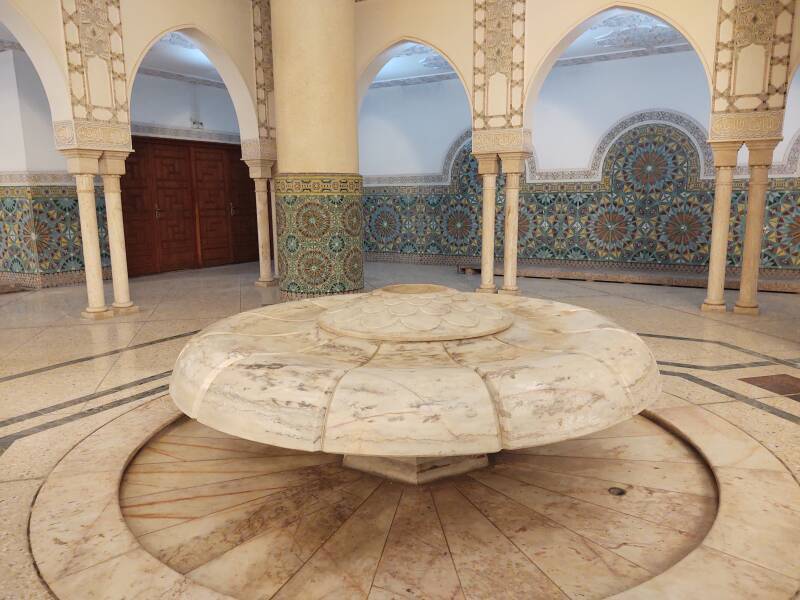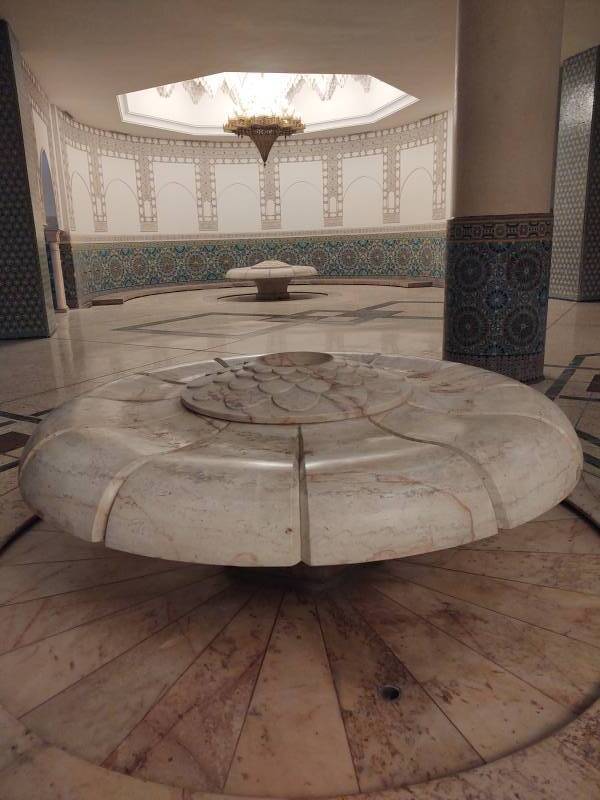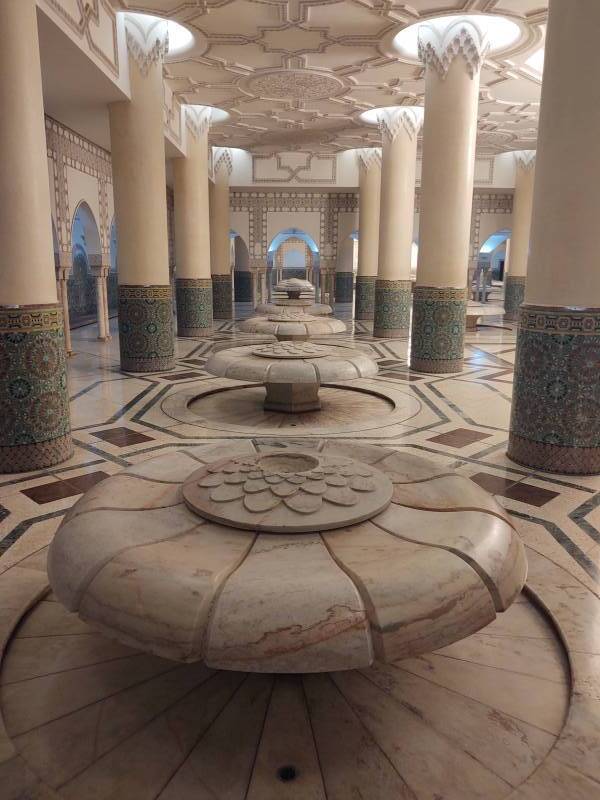
Hassan II Mosque
The Enormous Hassan II Mosque
From its consecration in 1993 until it was surpassed in 2019,
the Hassan II Mosque was
the tallest religious structure in the world.
Its 210-meter minaret made it taller than
any other minaret, steeple, dome, or pyramid
the world had ever seen.
The Great Pyramid of Khufu at
Giza
was just 146.6 meters tall originally,
a little taller than Saint Peter's Basilica at 138.6 meters.
The spire of Notre Dame de Paris was 91.4 meters
before the 2019 fire.
The mosque's worship services can host up to 25,000 people
inside with another 80,000 in the vast plaza outside.

King Hassan II, who took the throne in 1961, commissioned Morocco's most ambitious construction project in 1980. His original dream was of a mosque second in size only to the Masjid al-Haram in Mecca. However, that would require a structure larger than al-Masjid an-Nabawi in Medina, which can hold 1.5 million people in its 384,000 square meters. That simply was not practical, and the project was scaled back.
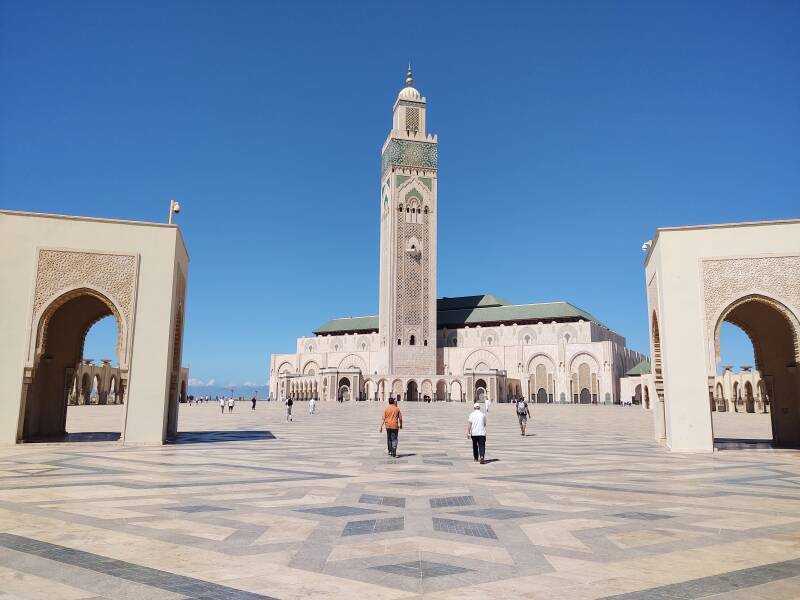
Construction started in 1986, and it was hoped that it would be finished in 1989 by Hassan II's 60th birthday.
The project was delayed, and the mosque was formally inaugurated in August 1993.
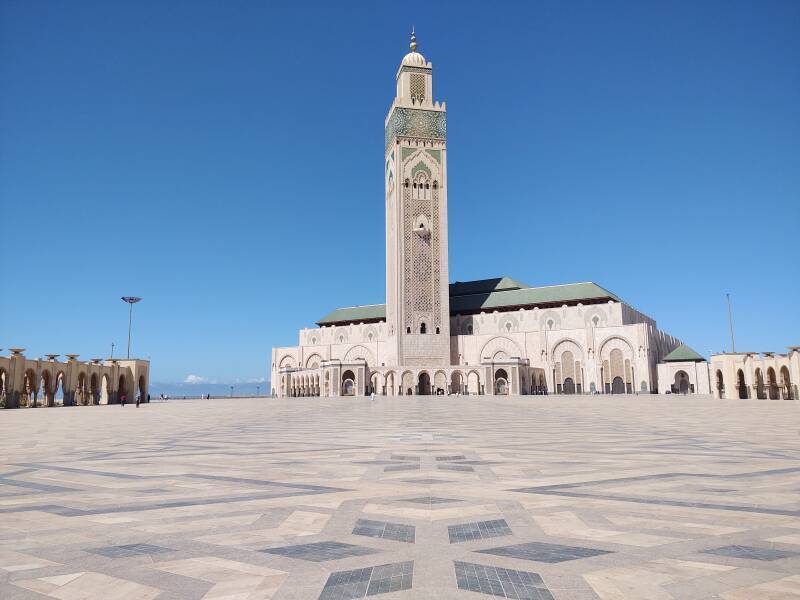
When was the prophet Muhammad born? No one knows, the year is an approximation. But there's a tradition that he was probably born in a particular month, and possibly on one of two days of the month. And so, it was getting finished in 1993 and 30 August 1993 of the Common Era calendar aligned with one of those days of the Hijri calendar, and that became the day.
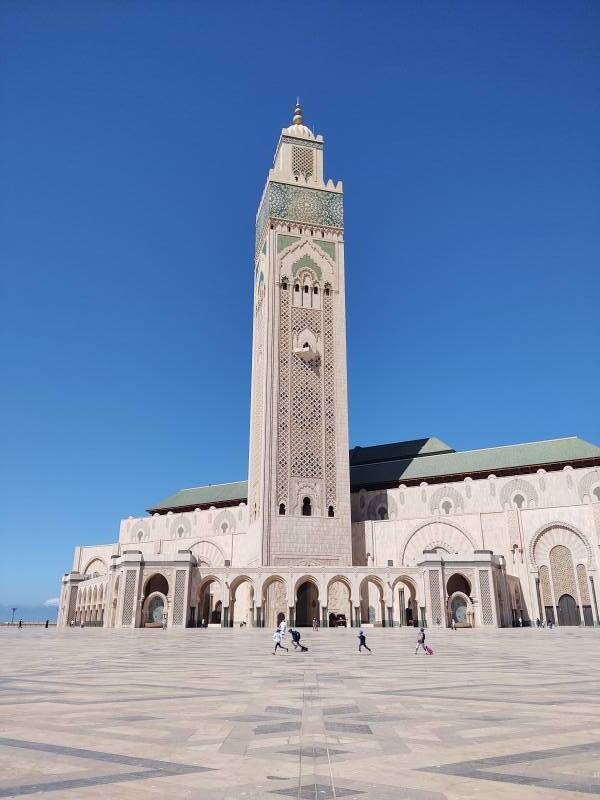
The whole complex covers nine hectares, partly on a filled-in area of seafloor. A 480-meter-long seawater swimming pool had been built here in the early 1930s and was considered the largest swimming pool in the world.

Its construction on an extension from the original shoreline leads to a persistant legend that the mosque has a glass floor through which you can look down into the ocean. Or even that the mosque's floor is below sea level and large glass walls provide an underwater view.
No, even its lower levels are well above sea level. But there is a fine view out over the Atlantic Ocean to the north.

It was designed by a French architect who lived in Morocco, and built by a French industrial group at an estimated cost of 585 million Euros. Much of the cost came from individual donations, with the rest from businesses and wealthy Arab countries including Kuwait and Saudi Arabia.
The decoration combines vegetal forms of vines and flowers with complex geometric forms.
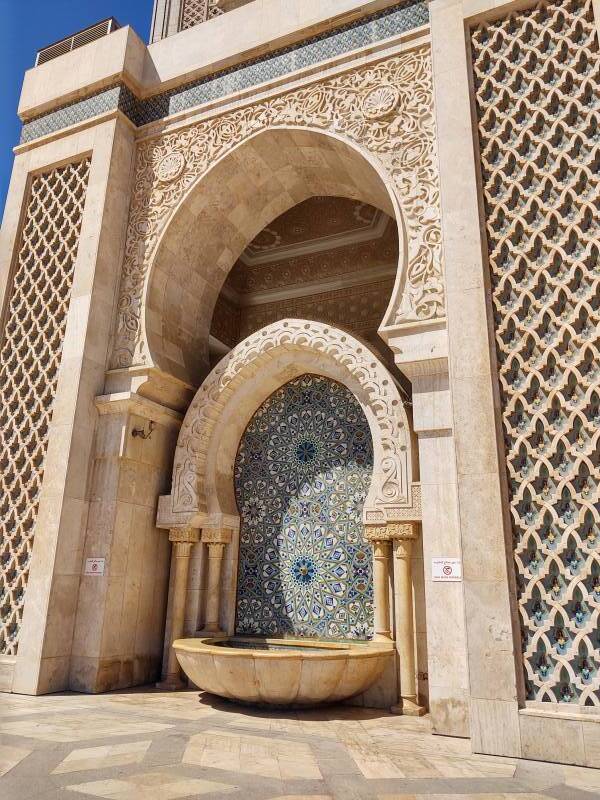
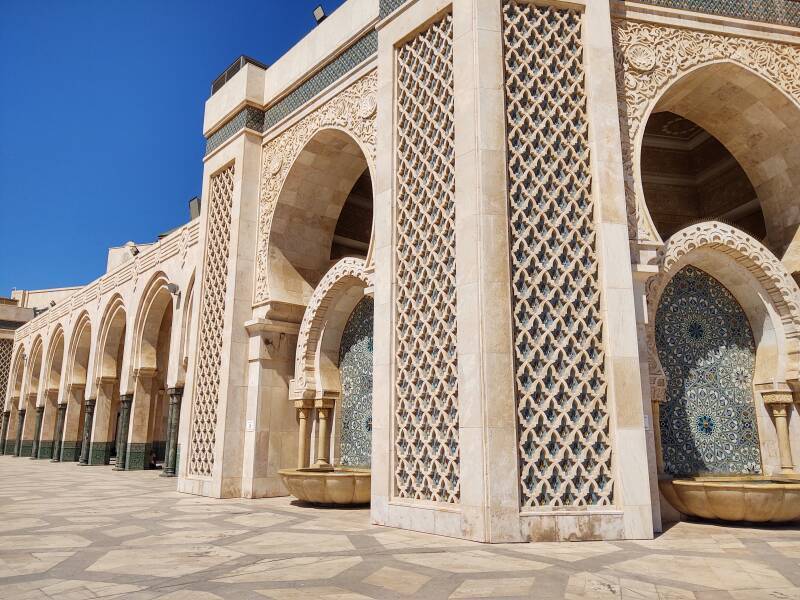
A laser beam projects from the top of the minaret in the direction of Mecca.
Given the immense weight of the minaret, the contractors came up with an extra-strength concrete resistant to 1200 bars/m2, four times the strength of ordinary concrete. They also had to consider strong winds blowing in off the Atlantic and possible seismic activity.

The Djamaa el Djazaïr in Algiers was completed in April 2019. Its minaret is 265 meters tall.
I was there on a Friday, when the week's main service was going on.
Non-muslims can only visit this mosque on a tour. And, this is the only mosque in Morocco that a non-muslim can visit.
That's actually a French-imposed law left over from the Protectorate. At the end of the French Protectorate, Morocco decided to keep that.
I've been to lots of mosques throughout Turkey, in Damascus and Aleppo, and in Cairo, but the size and unusual design of this one made the tour worth the hassle. Meanwhile, I sat outside and listened, then watched the crowd of people leave.
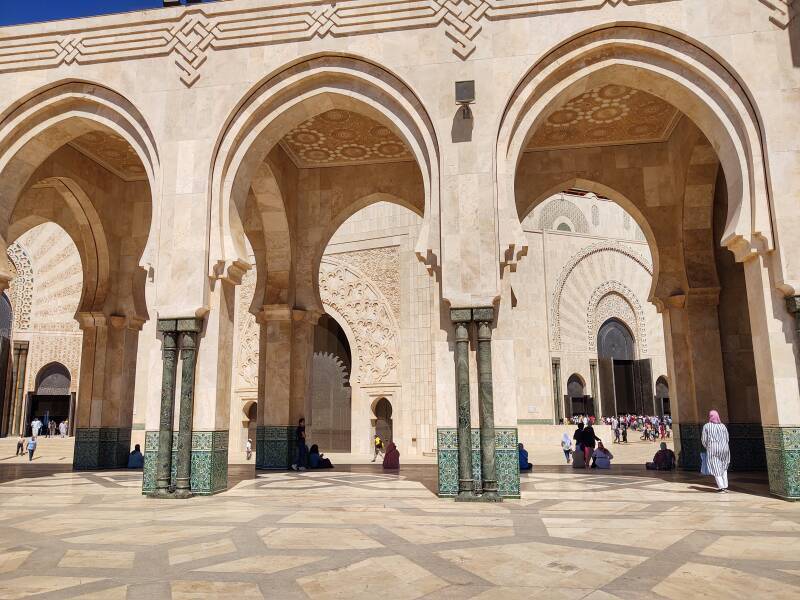
I would guess that at least a thousand people had attended. Many seemed to have made a special trip for the service.

It had been a while since I had been to a mosque. I was thinking back. Of course you remove your shoes, because you are about to walk on carpets where praying people will put their heads. There will be some special zone at the door where you remove your shoes while stepping off the border strip onto the interior floor.
To really do it right, put your shoes sole-to-sole and hold them by the toes, with your left hand. Then make your first step into the mosque with your right foot.
Well, it seemed that no one was being that elaborate. I was remembering the Egyptian version, done where they make a bigger deal of exhibiting signs of piousness. I later noticed that a few men in Moroccol have a prayer callus, but not many. That's especially an Egyptian thing. What's the Arabic for "Holy Roller"? I don't know the word but I think I can recognize what it describes.
Anyway, I could see the shoe removal and re-donning at one of the nearby doors.
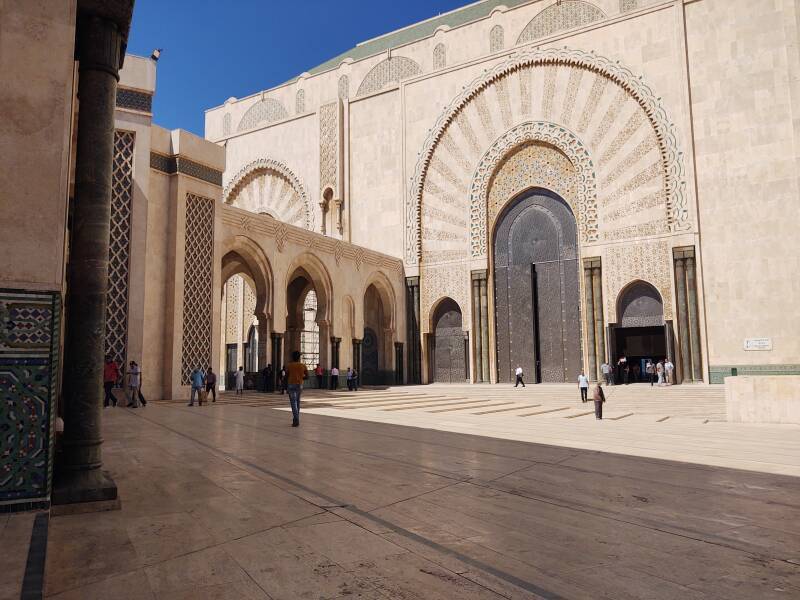
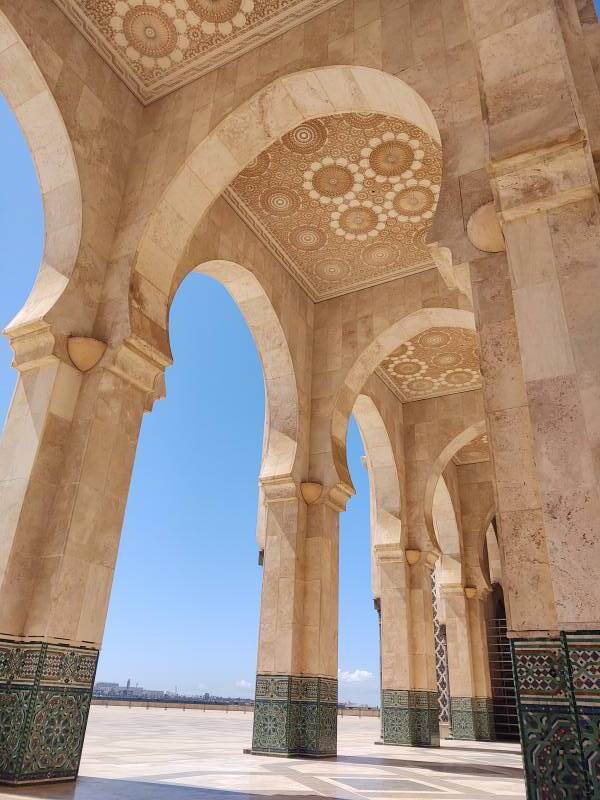
Then the part that surprised me. They had ushered everyone out of the mosque and closed the doors. Then they told everyone sitting nearby, or walking around the immense plaza, that they had to leave. That was a surprise to me after what I had experienced in Turkey, Syria, and Egypt, where mosques remain open.
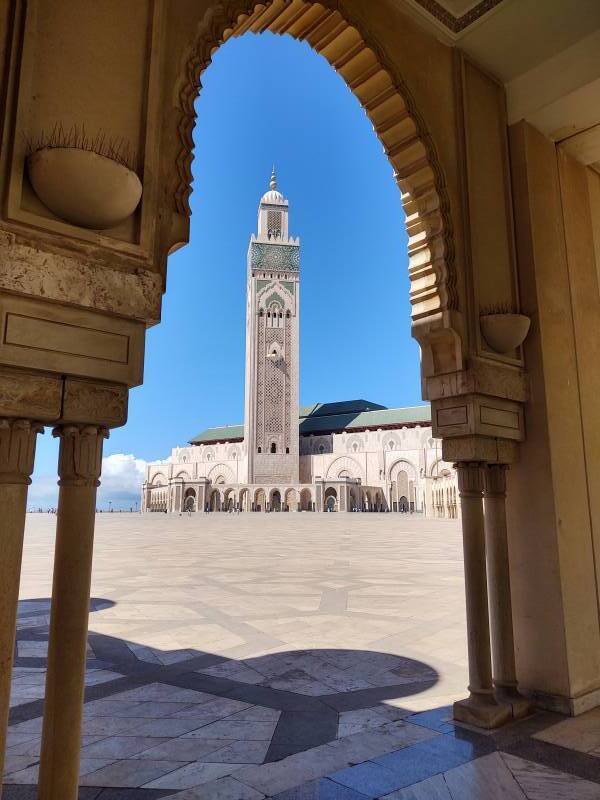
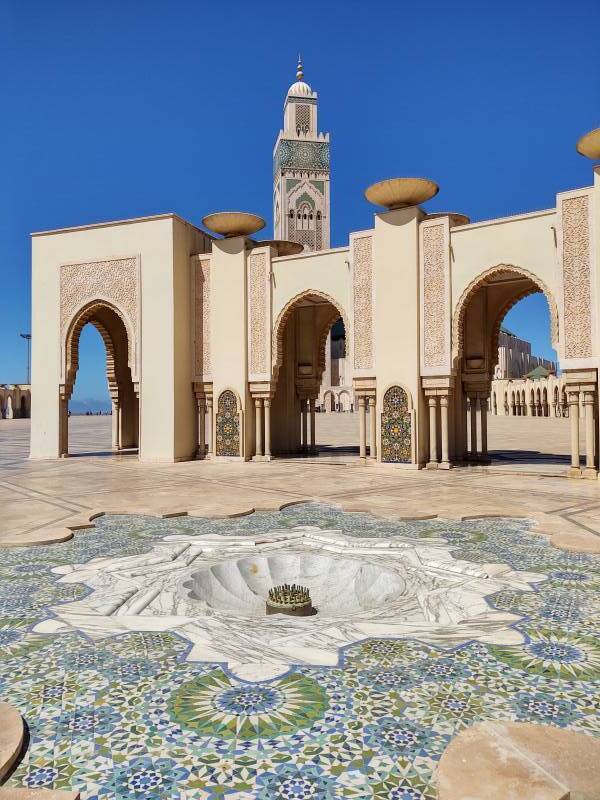
So, it was back to the museum at the street, where they soon began selling tickets for the 15:00 tour.

Touring the Interior
There were guides speaking a variety of western European languages. The prayer hall is 100 by 200 meters, with its central nave 40 meters high, there was plenty of room for several groups.
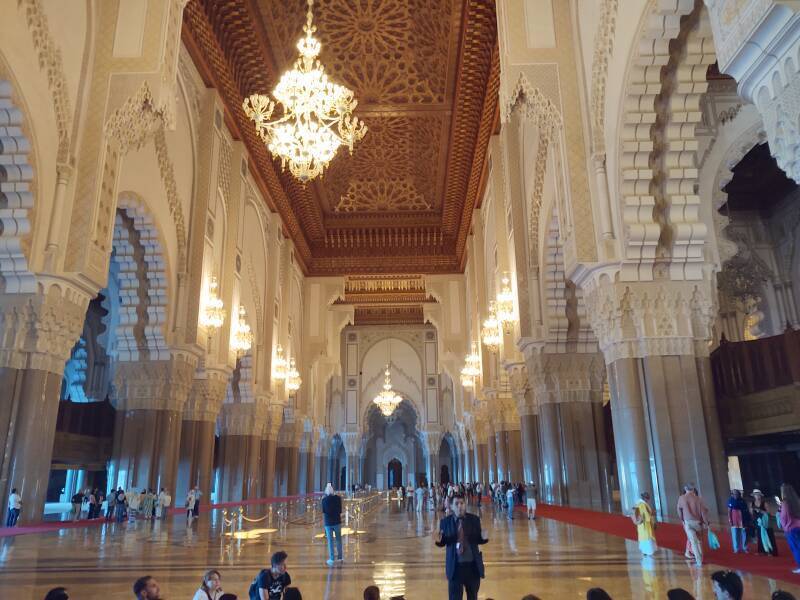
The English-speaking guide, standing in the picture above, told us some details then asked if anyone had any questions so far.
| American woman: | Is this still used for religious services? |
| Guide: | Yes, of course! |
| American woman: |
[Looking around in confusion]
But, but... Where do they do the baptisms? |
| Guide: | ... This is a mosque, you are thinking of a Christian church. |
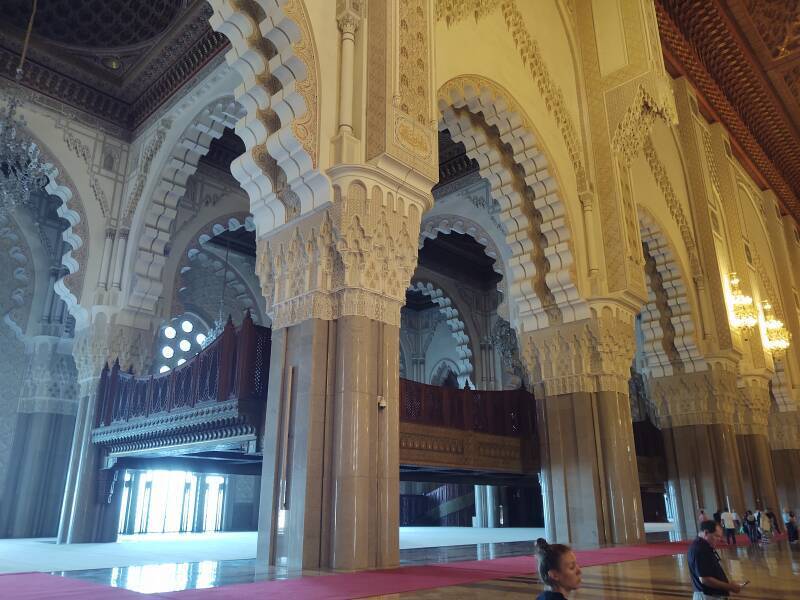
The wooden mezzanine levels in the side naves are where the women go.

There are glass panels in the floor along the centerline of the nave. Below you can see a pair of them, lighted, with ropes around them.
However, you look down into the ablutions area, not into the ocean.
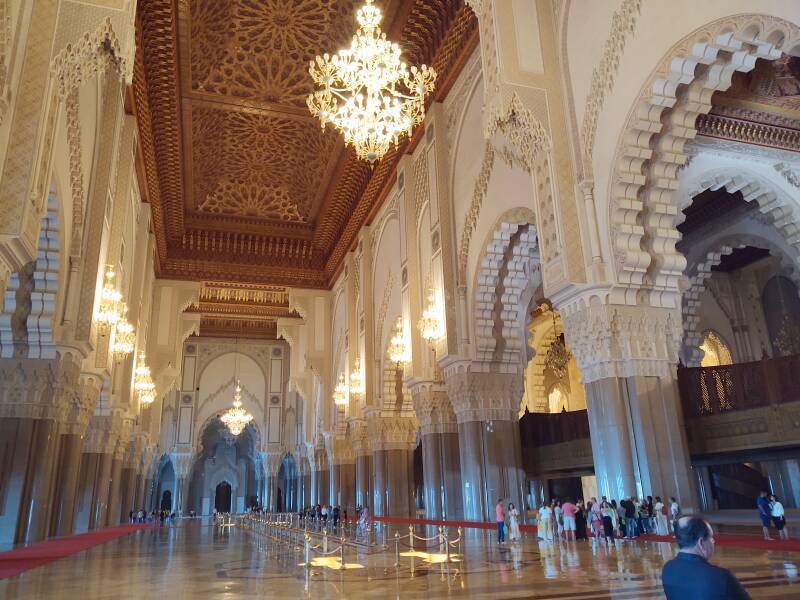
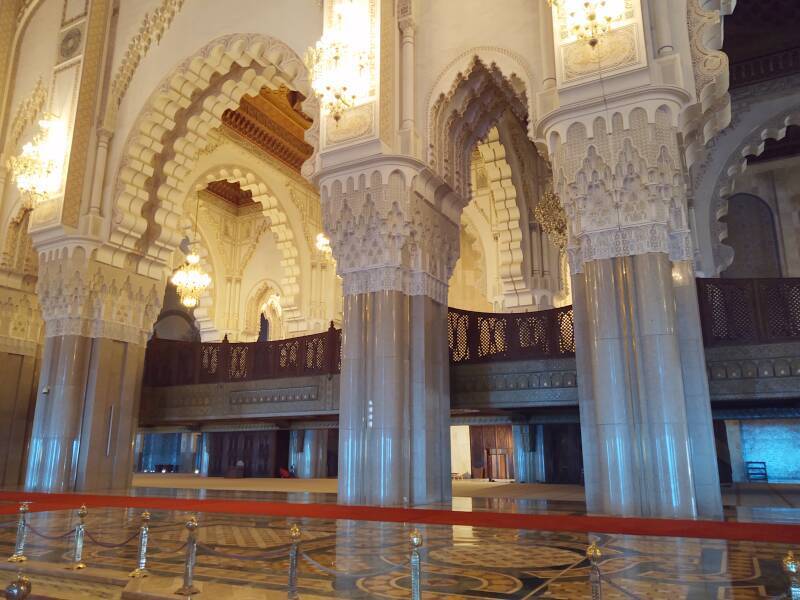
The mosque is two hundred meters long, front to back, and one hundred meters wide, left to right. That is an unusual design.
Ottoman mosques tend to be roughly square. I don't know, but I wonder if that is due to influence from Greek Orthodox church architecture.
Other mosques, certainly most of those I have seen, tend to be much wider than deep. The idea is that everyone is facing the same way, in parallel, toward the front wall. If the prayer hall is much wider than deep, then it's obvious that no one is sitting very far toward the back. It's meant as an architectural message of "we're all equal before God."
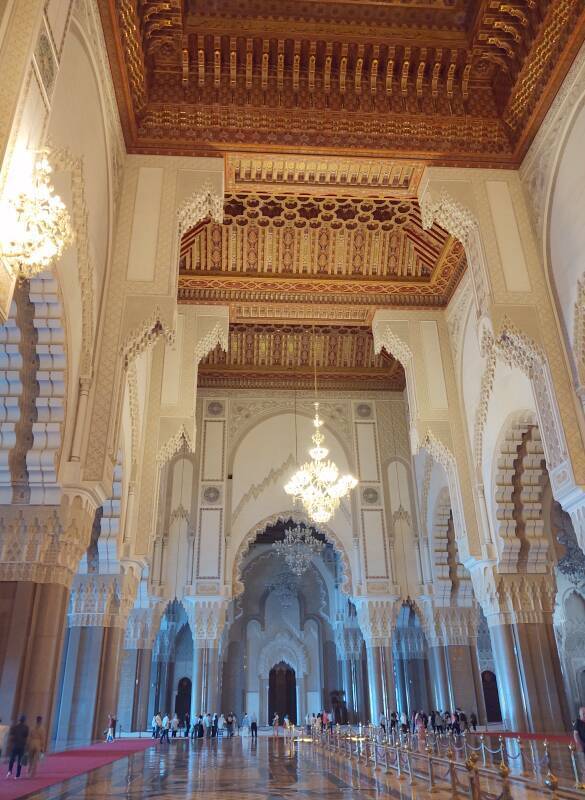
Here, however, the planned total area along with the constraints of the site forced a long and narrow prayer hall.
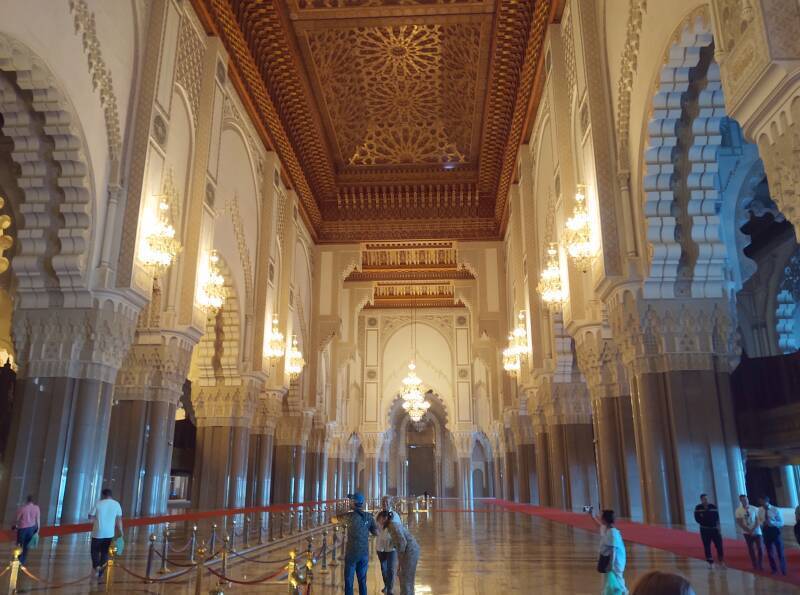
The front wall, seen below, will have a mihrab or niche indicating the qibla or direction toward Mecca. Specifically, toward the Kaaba, the black roughly cubical structure that is the most sacred site in Islam.
More on early sacred bouldersThe Kaaba is roughly cubical, 12.86×11.03 meters in area and 13.1 meters tall. The al-Ḥajaru al-Aswad or Black Stone is set into the eastern corner of the Kaaba. Legend says it's a meteorite but geology disagrees.
The Black Stone and an early version of the Kaaba were there long before Muhammad's time. The site was used for worshiping the deities of pre-Islamic Bedouin religions, or possibly Hubal, a Nabatean deity.
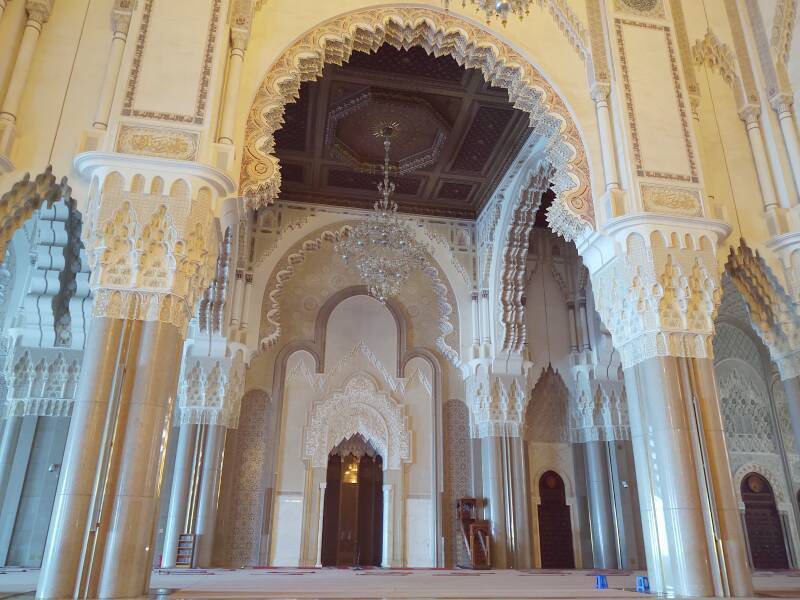


To the Ablutions Level
We exited the prayer hall to an entry foyer that led down to the men's ablutions area.
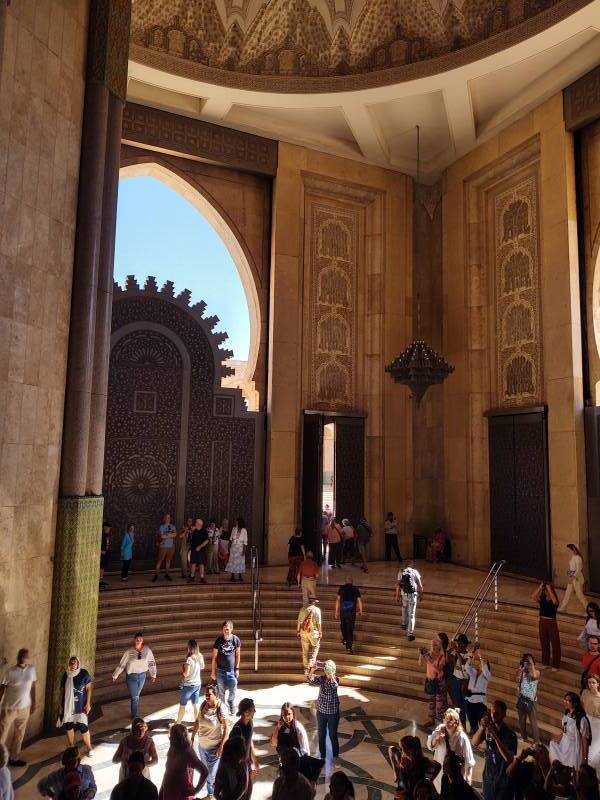
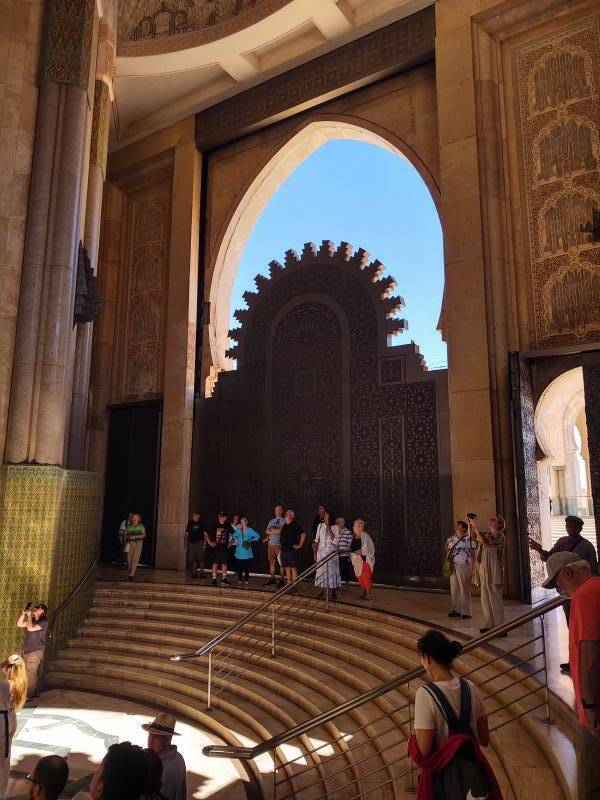
Wuḍū is the Islamic procedure for cleaning the face and head, hands and arms to the elbows, and feet up to the ankles.
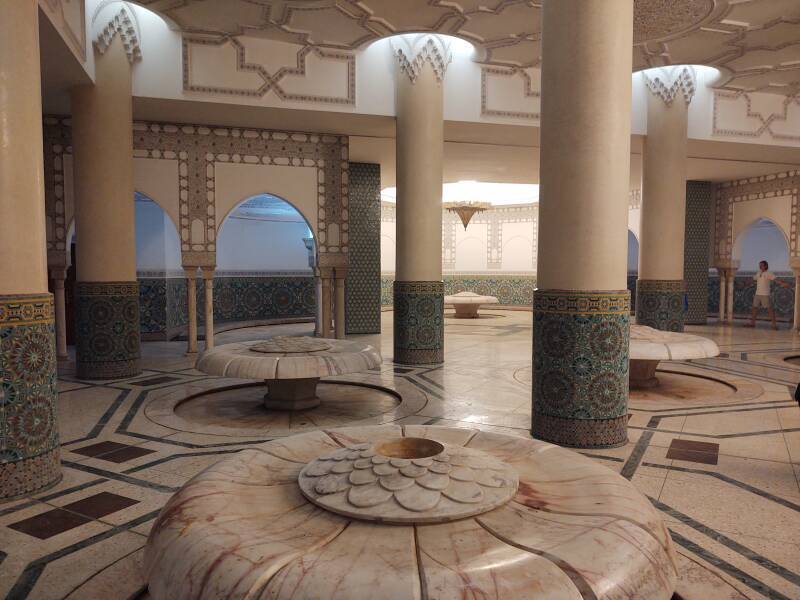
O you who have believed, when you rise to perform prayer, wash your faces and your forearms to the elbows and wipe over your heads and wash your feet to the ankles. And if you are in a state of janabah, then purify yourselves.
— Quran 5:6
